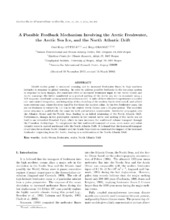A Possible Feedback Mechanism Involving the Arctic Freshwater, the Arctic Sea Ice, and the North Atlantic Drift
Journal article
Permanent lenke
https://hdl.handle.net/1956/628Utgivelsesdato
2004-03-15Metadata
Vis full innførselSamlinger
- Geophysical Institute [1198]
Sammendrag
Model studies point to enhanced warming and to increased freshwater fluxes to high northern latitudes in response to global warming. In order to address possible feedbacks in the ice-ocean system in response to such changes, the combined effect of increased freshwater input to the Arctic Ocean and Arctic warming—the latter manifested as a gradual melting of the Arctic sea ice—is examined using a 3-D isopycnic coordinate ocean general circulation model. A suite of three idealized experiments is carried out: one control integration, one integration with a doubling of the modern Arctic river runoff, and a third more extreme case, where the river runoff is five times the modern value. In the two freshwater cases, the sea ice thickness is reduced by 1.5–2 m in the central Arctic Ocean over a 50-year period. The modelled ocean response is qualitatively the same for both perturbation experiments: freshwater propagates into the Atlantic Ocean and the Nordic Seas, leading to an initial weakening of the North Atlantic Drift. Furthermore, changes in the geostrophic currents in the central Arctic and melting of the Arctic sea ice lead to an intensified Beaufort Gyre, which in turn increases the southward volume transport through the Canadian Archipelago. To compensate for this southward transport of mass, more warm and saline Atlantic water is carried northward with the North Atlantic Drift. It is found that the increased transport of salt into the northern North Atlantic and the Nordic Seas tends to counteract the impact of the increased freshwater originating from the Arctic, leading to a stabilization of the North Atlantic Drift.
